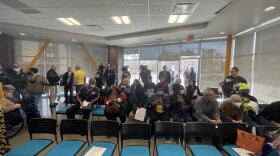State officials from the Ohio Department of Transportation Drive Ohio initiative updated the public in Trotwood Friday afternoon about progress on Electric Vehicle (EV) infrastructure development in the state. They said the plan is to install Direct Current (DC) Fast Charging stations every 50 miles along most Ohio interstates within a couple of years.
DC Fast charging stations are important because they can fully charge an electric vehicle in 20 minutes to an hour. Compare that to Level 2 Alternating Current Charging Stations (what most people have in their homes), which take 4-7 hours to fully charge. Experts say putting enough Fast Charging stations along roadways will be essential for EV drivers to have a predictable and reliable experience when taking trips or commuting.
“The goal is for it [DC Fast Charging Stations] to be placed every 50 miles on main routes so EV drivers can drive long distances confidently with someplace to charge,” Managing Director of Communications and Policy for DriveOhio Breanna Badanes said in an interview with WYSO before the public meeting.

President Biden’s 2021 Infrastructure Law provides more than $100 million over the next five years to install Fast Charging stations in Ohio through its National Electric Vehicle Infrastructure Formula program.
Rap Hankins, president of the local EV advocacy group Drive Electric Dayton, helped organize Friday’s meeting. Hankins said the location of the meeting, a predominantly Black suburb, was intentional and that his organization wants to make sure people in Trotwood have their voices heard as NEVI funds continue to be distributed across Ohio.
“That whole economic development piece should be in all communities, in all parts of Ohio, no matter if you’re from Appalachia, Trotwood, Cincinnati, or whatever.” Hankins said, “In the past, we haven’t seen that equity when it comes to new technology.”
Attendees also had a chance to see electric vehicles and talk to EV car owners, including Hankins.
Some free market advocates have spoken out against programs like NEVI, which they consider to be government subsidies for the EV industry. One critic, president of local fossil fuel distributor Hightowers Petroleum Co.’s Stephen Hightower, said the following in an opinion piece with the Columbus Dispatch earlier this month:
“We didn’t get thousands of fueling stations across Ohio through social engineering or government subsidies, and we shouldn’t use such tactics to create an EV charging network. Instead, let’s allow competition, innovation, and the free market to thrive.”
WYSO reached out to Hightowers Petroleum requesting an interview with President Hightower and did not get a response by publication.
Currently, 3% of registered vehicles in Ohio are EVs, but that figure is trending upwards as manufacturers invest in EV technology and prices continue to decrease.





